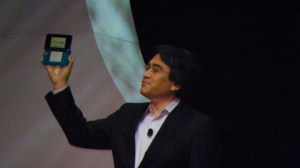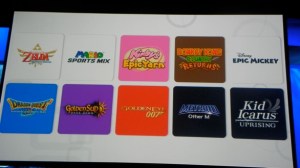When Peter and I got to the Nintendo meeting rooms behind the Japanese gaming giant’s huge E3 booth, Satoru Iwata was pecking away at one of Apple’s Macbook Pro laptops. He folded it shut and quickly stood up to greet us, but I found it telling that the president of Nintendo’s worldwide operations would be using a Cupertino-built computer.
Both companies get criticized for the way they tease and tantalize their faithful, and get accused of dumbing down their products to make them more blatantly commercial. But, critics of both companies have had to stand by while both became dominant in their respective arenas. Yes, Nintendo and Apple are circling each other warily in the handheld gaming market, but Nintendo’s been top dog in that section of video games for more than two decades. Their latest portable, the depth-centric 3DS, may just be the key to extending that supremacy.
Iwata talked about the 3DS and more during our chat, going deep into how Nintendo develops products, what he sees as the company’s core mission and the things that frustrate hardware engineers who work at the House of Mario. President of Nintendo since 2002, Iwata-san rarely gives interviews to American media outlets and we think that his comments should shed some significant light onto the guiding principles of Nintendo as a company. Read on to hear from the man guiding the biggest video-game company in the world.
I think usually the perception is that Nintendo holds back to kind of keep fans interested and anticipating. I was not expecting to see quite so many titles announced at the press conference this year. What was the decision behind announcing so much this year?
Well, we reviewed what we could learn from the past few years. Most specifically, we reviewed what our customers’ expectations were towards Nintendo’s E3 presentation. These lessons affected how Nintendo presented some of our games this year.
Also, our key appeal yesterday during our E3 presentation was without any doubt the 3DS. At the early stage of thinking of how to structure the presentation, we decided we really wanted to show the Nintendo 3DS at the tail end. When we thought about how should we construct the flow, it was relatively easy for us to lead with software. It appeared that so many people were excited with our announcement yesterday, so at least I’m very glad about that.
I think what surprised people was the ability to get to see it and get hands-on with the 3DS right away. What was the decision-making process behind that?
We’ve been thinking very carefully about how can we possibly communicate the real value and the attraction of Nintendo 3DS. The conclusion was that there is no other way than to let as many people as possible to actually see it. We really wanted to have the 3DS available at the tail end of our E3 briefing and decided that the very end of the presentation would be an actual hands-on.
(More on Techland: Nintendo Makes the 3DS Official, No Goofy Glasses Required)
So is this pretty much what the unit is going to find the production unit is going to look like?
This is still not the final exterior design. We’re anticipating some minor modifications. I’m not anticipating major changes from this but there may still be some minor changes.
It seems as though in the last few years with Nintendo’s handhelds, the product roadmap has been pretty accelerated. You have the DSi and then the XL and now the 3DS. Is there a specific reason why you’ve rolled out so many different handhelds in the last two or three years? Is it to combat other handheld gaming devices and other things like the iPhone?
At Nintendo, we have never thought that way. For example, from the original DS to the DS Lite, there’s just some minor functionality differences. But, then, you see the difference from the DS Lite and DSi transition. That kind of transition involved several major functionality additions. And as you noted, the DSi to DSi XL transition has simply the slightest difference, with the better view angle. We’re bulding variety, as with different color variations for the hardware. That’s our basic understanding towards how we approach the new iterations with the same functions.
In the case of the Nintendo 3DS, it’s supposed to be the successor to Nintendo DS. As soon as the development of the original Nintendo DS was over, we started working on the successor to it. We’ve already spent six years in order to develop this Nintendo 3DS. In other words, the development of the successor or Nintendo 3DS has been taken on in parallel with working on the additional new models and new colors to the Nintendo DS.
So, are you saying that the research for the 3DS doesn’t build off of previous DS iterations? Or was it a separate project?
Separate.
Okay, separate project. For six years, then, you guys have been thinking about the idea of 3D on a handheld?
I’m sorry; I might have confused you. When we first considered the successor for the Nintendo DS, we didn’t come up with 3D as the first and foremost idea to be incorporated. Rather, we first tackled much broader concepts like the processing power, what kind of graphics capability the successor will be able to have and thinking ahead to what kind of new functionality should be available for the gaming device. Those basic concepts came first.
If we can shift to the Wii now, it seems like the software library moving forward is going to be a lot more graphically impressive. Do you feel that’s because people are devoting separate teams and more time to games on the Wii? Or, are third-party companies learning lessons from internally developed Nintendo games?
Yeah, I think you’re right in both senses. There are two things going on. One is that it’s been some time since we’ve launched the Wii and the developers have accumulated some know-how in taking advantage of the Wii’s capability. And another thing is, more and more teams appear to be more interested, spending more time and more energy and more resources in order to create one Wii title.
Compared to last year’s E3 presentation than this year, there are a lot more first party titles coming from Nintendo. Is that a result of third party developers not being able to sort of create the right game for the Wii platform?
Yes, there are some third-party people who sometimes cannot tell what kind of software can actually sell on Wii hardware. Some third-party developers may not be very happy about the fact that, while Nintendo’s titles are selling very well on Nintendo’s platform, their titles are not selling that much.
But, when we look objectively at that and see the sheer number of third party titles sold on the Wii, it’s actually huge. When we compare the third-party titles with the Nintendo’s first-party titles, comparatively that number appears to be less. As you know, most of the key franchise titles by the third parties are sold across multiple platforms. Between Wii and other platforms, they might find that the Wii might not be the most lucrative platform for them.
That’s an honest assessment. Going off of what Miyamoto-san said about folks not being able to really tap the full potential of the current hardware, is it safe to assume that (a) you do have sort of next generation hardware plans already in place and then, (b) once developers, whether it’s Nintendo developers or third party developers can actually push the limits of the hardware, is that what we might be able to see the next generation?
Yes. The point is not necessarily the limit of the technologies, but rather we should think in terms of the software, whether or not we would be able to come up with a new great software idea is the key.
So to ask a little bit more about software from third-party partners, I just came from seeing Epic Mickey this morning and talking Warren Spector. The game looks amazing and he’s obviously a great designer. What other games you feel are going to be very important in the next 12 months or so from third party partners for the further future of Wii?
I might not be the best person to answer that kind of question, because I myself am not in a position to talk directly with these software publishers. But as I said, during my presentation on the Nintendo 3DS yesterday, Nintendo really had to depend upon its own software titles in order to come up with a certain level of [momentum] during the launch period of Wii and DS. Because there were so many Nintendo titles coming out, a lot of the first party titles appeared to be selling well in comparison to the share number or the third-party titles. That [kind of momentum] is typically said to be successful in the marketplace, but Nintendo Wii doesn’t think that’s an optimal situation where Nintendo appears to be the leading software on Nintendo platforms. That’s a situation we definitely want to change. Fortunately, we’re receiving so much support now from third-party partners for the Nintendo 3DS at this stage. The message yesterday was that we really appreciate the third party support, be it for Nintendo 3DS, the Wii or DS. And of course, we do not believe that the first party software [alone can] sustain the whole hardware install base and maintain the momentum for the Wii or DS.
(More on Techland: E310: Warren Spector Talks About Why Epic Mickey Will Live Up to Its Name)
Speaking of momentum, your competitors are implementing gesture and motion control into their consoles. Do you feel that there is no longer any separation between the Wii and the PS3 and the 360? Where do you feel the advantage lies for the Wii?
First of all, it’s very important to note that every single Wii system available in the marketplace is a motion-control applicable system. While on the other hand, other companies are now just trying to start selling the peripherals with motion-control technology. And now, it’s their mission to sell the motion control system one by one to each consumer to see how each one of these consumers is going to respond to their offer. So in terms of the sheer install base, there is a huge difference at this point in time and in the near-term. So thinking in that fashion, we do not think that we are losing the edge in terms of the motion control arena at all.
And another thing is that we understand we became the pioneer of the motion-control experience by offering Wii Sports together with the Wii hardware. And, then, we came up Wii Fit [which also changed expectation about what motion gaming could do]. And now, we are adopting the Wii motion control technology to the new Legend of Zelda. So, in other words, we are always trying to explore new horizons all the time—even in the field of motion-sensing experiences.
So there are two different things, the technology called motion control and there is X software which takes advantage of the motion control. The end-result is the experience, which is the most valuable thing for the consumers. And as long as we are keeping our steps forward, I think we can keep our edge.
So what are the steps forward? Is that primarily making sure that the hardware can support software ideas? Reggie said at GDC that Miyamoto-san says that he feels he hasn’t yet fully tapped the power of the current Wii. Is that where the path lies, making sure that creators can do everything they want on the hardware?
First of all, Nintendo does not think in terms of the life spans of hardware should have. [We don’t think in terms of] we are going to make this kind of software at this stage of the lifespan or what kind of software shall there be at the tail-end of the life cycle. We are not thinking in that fashion. When we have to admit that we cannot make any great new experiences to provide the consumers with the current hardware system, that’s the time when we need to consider offering new hardware.
So looking at Wii, we believe that we still have more potential that we have not explored yet. And in that sense, we can just kind of tell when we need to make the announcement about the next generation hardware. Just as I said about the example of the DS and 3DS, as soon as development on one hardware is completed, we start working on the next one. The successor to Wii has already been under development and review since the completion of the Wii hardware design. It’s quite another story as to exactly where or approximately when we will be able to make the next hardware announcement.
(More on Techland: The Techland Interview: Nintendo of America’s Reggie Fils-Aime)
Is that in an intuitive decision? When do you decide, okay, now the marketplace is ready? Like, for example, why is the marketplace right now ready for the 3DS?
In the case of Nintendo 3DS, we first have to think in terms of what remains to be done with the DS and its further potential. Sometimes we feel that things have already come to the stage where there are not many more ways that we can take advantage of the current Nintendo DS hardware configuration. Probably sometime in the near future, [we will feel] that our applications will be more of the same and we will have to come up with some brand new proposals. So we’ve looked into different possibilities, including 3D. When we did our own experiments utilizing the 3D technology, we concluded that this is something that has potential.
I should a little bit more elaborate on that, because our approach might be a little bit different. Typical tech-driven companies or hardware-driven companies always lay out the so-called roadmaps when it comes to making the new hardware. So, in other words, availability of certain technologies dictates when the company is intending to make the new hardware. A typical example of that would be the PC companies. Most of them are actually receiving technical roadmaps from Intel. And knowing when the next generation of [components] would be available, they are going to design or have already designed the next generation PC schedule.
It’s not like that at Nintendo, though?
At Nintendo, it’s very different. The poor guys in hardware development always have to ask the software developers, “Is this the year that you are likely needing new hardware?” [Laughter] And they are always working on the assumption that this year or next year, they’ll need the new hardware. But part of that thinking is what kind of things can be done with the new components?
I imagine the engineers might be frustrated that they don’t get to play with the newest technology right away. But essentially, what you’re saying is that you’re software-centric, and that’s the core part of Nintendo.
Right. Of course there are some people who really love high-tech at Nintendo and I have to admit that some of them must be sometimes frustrated. I will say, however, that everybody at Nintendo is pretty much aware that it’s not hardware nor is it software alone, but it’s the experience which matters and the experience delivered to consumers can be only realized by a perfect combination of the hardware and software.
What do you see as Nintendo’s mission as a content creator?
At Nintendo, we believe our mission is to try to expand the gaming population. In order to expand the gaming population, I think several things are necessary. These are the Nintendo challenges: To those who have never played with video games, we need to make experiences that [will make them] interested. And for those who are not very good at video games even though they’re playing them, we need to make it so that they can become better and better. [so] they feel like they can play with veteran game players together in the same game. And eventually, we want them to be skillful, to become the veteran game players. And for those lapsed players, those who used to play before but who are not playing anymore, we need to interest them into become gamers once again.
(More on Techland: Jumping to a New Level: Techland Reviews Super Mario Galaxy 2)
Of course, it’s the consumers who are going to decide whether or not they are willing to take up Nintendo’s efforts, but we don’t want to stop these efforts to expand the gaming population. By doing so, we hope the consumers are going to think of Nintendo as the company trying to continuously provide them with some innovative ideas and proposals. The term “innovative” or “innovation” is often vague or ambiguous. But in our definition, innovation means to make something which people think impossible possible.
I want to talk about 3D a little bit. Do you feel like there might be cultural differences between America and Japan about how the consumer desire for 3D? Is the Japanese film industry as crazy for 3D as Hollywood is here?
I think the business success of Avatar actually set off the Japanese movie creators’ spirits and a lot of them are now saying that, okay, this is the year for the 3D movies.
Okay, but do you feel like the Japanese consumer is excited as well or you think it might be different here in America?
I think that 3D itself has definite appeal to anybody. It [acts on] a kind of instinct [inside of us]. But Japanese households in general are much more smaller than your houses. And because of that, our houses are not very good for the huge screens that are better for the 3D viewing.
But, as for my objective view as to when 3D TV sets are going to become widely available at general households, I have to say it is going to take some time. It’s one of those typical controversies, I guess. On one hand, the hardware manufacturers probably may be complaining about a lack of 3D content, while the software manufacturers might be complaining about a very small install base of 3DTVs. And adding to that is the issue of the special glasses. The Nintendo 3DS is actually a combination of a gaming device AND a display which supports 3D viewing. We’re offering this kind of integrated system without the need to wear any special glasses and I think it’s one of the answers for that issue. We think Nintendo 3DS can be an instant 3D solution that has the possibility of widespread availability [compared to] the possible spread of 3D TVs.
If it’s okay, I’ll end with a personal question. Will you be getting a 3D TV in your home? Are there any in the offices at Nintendo?
Actually, we’ve installed a 3D TV set in one of our headquarters’ conference rooms that I often use. At my home, I have not purchased the 3D TV yet, but I’m one of those guys who are interested in purchasing anything new on the market. So I think in the near future, I’m going to buy one.
(More on Techland: Would You Read Books In 3D?)





